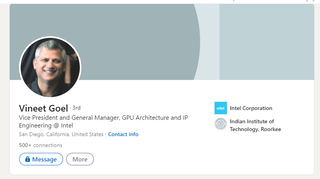Intel Poaches Top AMD GPU Architect to Lead Xe Development
Another graphics veteran joins Raja Koduri-led GPU team at Intel.

After radically changing its approach to GPUs and hiring Raja Koduri in 2017, Intel has been rather aggressively hiring GPU engineers from various companies in general and from Raja Koduri's former company, AMD, in particular. Last month the company poached Vineet Goel, a graphics technology veteran from AMD.

At Intel, Vineet Goel will serve as Vice President and General Manager of Xe GPU Architecture and IP Engineering at Intel and will be responsible for development of the company's Xe architectures. An Intel spokesperson confirmed to CRN that Goel will head a group of architects and engineers that will be 'architecting, designing and verifying Intel’s Xe IP road map.' Since the first two or three Xe architecture generations have already been defined (or at least named) Goel will have an impact on Intel's Xe GPUs that are years down the road.
Vineet Goel is has had quite a career in the graphics industry. Most recently he served as Corporate Vice President of GPU Architecture at AMD and before that (from August 2016 to June 2019) was responsible for GPU architecture development at the company. Given the timeline, Vineet Goel played a key role in development of AMD's latest RDNA and RDNA 2 as well as CDNA and CDNA 2 architectures. Furthermore, he also contributed strongly to development of upcoming RDNA 3 and CDNA 3 architectures as well as their successors.
Goel he started his career at Real3D in the late 1990s and continued it at ATI Technologies Orlando division after Real3D was sold to Intel in 1999. He worked at ATI and then at AMD till 2011, when he joined his former colleague Eric Demers at Qualcomm and worked on ultra-low-power Adreno GPUs for Snapdragon system-on-chips. He spent about five years at Qualcomm and then re-joined AMD in mid-2016.
Over his career Goel was granted dozens of graphics related patents, but avid readers might remember him for his work on ATI's TruForm and other tessellation technologies (for Microsoft's Xbox 360, ATI's Terascale/Terascale 2 architectures) supported by the company's GPUs over the years. His more recent inventions include FidelityFX Super Resolution, multi-instance GPUs, and chiplet-based machine learning accelerators.
Vineet Goel is a yet another ex-AMD graphics engineer or executive that Intel has hired in the recent years. The company has also hired multiple people from Nvidia. Among Intel's noteworthy hires in the recent years are Masooma Bhaiwala, Tom Petersen, Jon Carvill, Antal Tungler, Darren McPhee, Devon Nekechuk, Damien Triolet, and many others. Intel also recently boosted its game developers relations team with four highly-experienced executives.
Stay on the Cutting Edge
Join the experts who read Tom's Hardware for the inside track on enthusiast PC tech news — and have for over 25 years. We'll send breaking news and in-depth reviews of CPUs, GPUs, AI, maker hardware and more straight to your inbox.

Anton Shilov is a Freelance News Writer at Tom’s Hardware US. Over the past couple of decades, he has covered everything from CPUs and GPUs to supercomputers and from modern process technologies and latest fab tools to high-tech industry trends.
-
Groveling_Wyrm ReplyMoxNix said:The Intel way, if you can't steal it buy it.
That is the way ANY company will do it, not just Intel. Many other companies have done exactly that. See IBM, See Nvidia, See Microsoft, See AMD. How do you think AMD got Lisa Su to be their CEO? They poached her, by promising her the CEO position. -
husker One way to look at this is that competition is good and this will give consumers another option. I'm all for that. Another way is to wonder if the gaming ecosystem will want to play along or be dragged kicking and screaming the whole way. Will game developers want to support yet another set of manufacturer specific hardware optimizations? Will it use FreeSync or go the Nvidia G-Sync route with an intel specific "I-Sync" specification that monitor manufactures will need to support? Are card manufactures (ASUS, EVGA, MSI, etc.) going to take on the risk of splitting their inventory and manufacturing of mid to high end cards between Nvidia, AMD, and Intel instead of just the current two? There's a whole ecosystem out there that is going to have to adapt, and is going to need a reason to adapt other than to just offer more of the same with an Intel sticker on it.Reply -
renz496 Replyhusker said:One way to look at this is that competition is good and this will give consumers another option
competition is just an illusion at this point.
Most Popular




